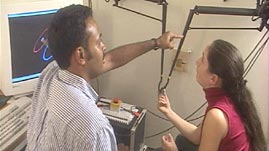Teachers' Domain - Digital Media for the Classroom and Professional Development
User: Preview

Source: Sciencenter, Ithaca, NY
"Ask an Engineer" is part of "Tech City," a traveling exhibition on engineering, developed for science museums with National Science Foundation funding. www.sciencenter.org Produced by Insights International.
The engineer's primary role is to develop practical solutions to society's many and varied needs. As demonstrated in this video from the Sciencenter in Ithaca, New York, engineering work — which requires creativity, a knack for problem solving, and lots of training — is seldom boring and can be highly rewarding. For some engineers, the challenge may be to maintain clean and healthy water conditions for aquarium inhabitants. For others, the work they do may be isolated from public view and involve the cutting edge of technology.
Do you want to know how information gets from one place to another over the Internet? Ask an electrical engineer. Some electrical engineers work in power generation and distribution facilities, while others, like the one featured in this video segment, are responsible for keeping fiber-optic systems — one of the most recent advances in data communications — running smoothly and efficiently.
Fiber-optic systems can transmit larger amounts of information more quickly and more reliably over long distances than can conventional electrical systems, which use metal-wire cables. For this reason, fiber optics is optimally suited for computer networks, including the Internet.
Fiber-optic cables are made up of hair-thin strands of transparent glass. As with an electrical cable, which is typically made of many individual copper wires, an optical cable is an arrangement of hundreds or thousands of optical fibers. The core, or thin glass center of each fiber, carries information encoded in a light signal. Surrounding the core is cladding, which functions to contain light within the core. Plastic coating called buffer coating surrounds the cladding, protecting the fiber from damage.
Here's how fiber-optic systems work. A transmitter converts an electrical analog or digital signal into a corresponding light signal. The light signal is then reflected along the fiber's core. As it travels, it continuously bounces off the reflective cladding until it reaches its destination: the optical receiver. Once there, the light signal is decoded into a replica of the original electrical signal. If the distance is particularly long between transmitter and receiver — as for transatlantic phone calls — an optical regenerator may be used to "boost" the light signal along the way.
Because the cladding does not absorb any light, the signal can travel a very long way with no significant loss. This translates into stronger and faster data transmission, which means clearer phone conversations and the ability to send and receive large data files, such as videos. Since tiny impurities found in the glass core will result in the loss of the signal, electrical engineers seek to remove such impurities.
Fiber-optic systems are less expensive than conventional metal wire ones, largely because cables made of glass are cheaper to produce than copper ones. Optical fibers are also thinner, so more fibers can be bundled into a given diameter of cabling. These additional transmission lines allow for the delivery of more data, which translates into an increase in bandwidth.
Despite their many advantages over copper-wire cable systems, fiber-optic systems must still be physically installed, which means digging trenches, submerging lines, or stringing cables through a building's infrastructure. All of these activities are time-consuming, expensive, and often disruptive to the environment. Before long, emerging high-speed wireless technologies may replace fiber-optic systems.
 Loading Standards
Loading Standards Teachers' Domain is proud to be a Pathways portal to the National Science Digital Library.
Teachers' Domain is proud to be a Pathways portal to the National Science Digital Library.
